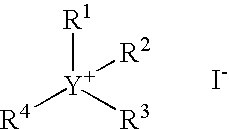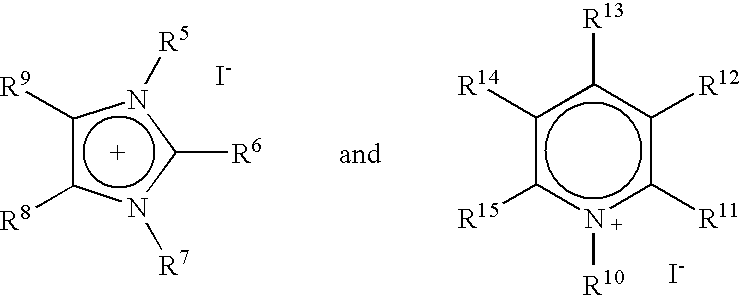Carbonylation process
a carbonylation process and carbon dioxide technology, applied in the field of carbonylation process, can solve the problems and high process control requirements, and achieve the effect of slow reaction rate, high cost and high cos
- Summary
- Abstract
- Description
- Claims
- Application Information
AI Technical Summary
Problems solved by technology
Method used
Image
Examples
example 1
[0040]To a 300 mL autoclave was added 0.396 g (1.5 millimole—mmol) of RhCl3.3H2O, 112.0 g (0.507 mol) of N-methylpyridinium iodide, 30.0 g (0.5 mol) of acetic acid, and 64.0 g (2.0 mol) of methanol. The mixture was heated to 190° C. under 17.2 barg (250 psig) of 5% hydrogen in carbon monoxide. Upon reaching 190° C. the gas feed was switched to 100% CO and the pressure adjusted to 51.7 barg (750 psig) using 100% CO. The temperature and pressure were maintained for 5 hours using 100% CO as needed to maintain pressure. After 5 hours, the reaction was cooled, vented, and the product transferred to a sample bottle. GC analysis of the product showed that the mixture contained 0.25% methyl acetate, 0.04% methanol, and 55.84% acetic acid. This represents 2.33 moles of acetic acid representing a net production of acetic acid=1.83 moles after accounting for acetic acid in the original solution and 0.008 mol of methyl acetate along with 0.035 moles of unreacted methanol. No methyl iodide was d...
example 2
[0041]To a 300 mL autoclave was added 0.396 g (1.5 mmol) of RhCl3.3H2O, 112.0 g (0.507 mol) of N-methylpyridinium iodide, 30.0 g (0.5 mol) of acetic acid, and 64.0 g (2.0 mol) of methanol. The mixture was heated to 190° C. under 17.2 barg (250 psig) of 5% hydrogen in carbon monoxide. Upon reaching 190° C. the pressure was adjusted to 51.7 barg (750 psig) using 5% hydrogen in carbon monoxide. The temperature and pressure were maintained for 5 hours using 5% hydrogen in carbon monoxide as needed to maintain pressure. After 5 hours, the reaction was cooled, vented, and the product transferred to a sample bottle. GC analysis of the product showed that the mixture contained 0.09% methyl acetate, and 57.42% acetic acid. This represents 2.52 moles of acetic acid representing a net production of acetic acid=2.02 moles after accounting for acetic acid in the original solution and 0.003 mol of methyl acetate. Neither methyl iodide nor methanol was detected in the product by GC analysis. This ...
example 3
[0042]To a 300 mL autoclave was added 0.396 g (1.5 mmol) of RhCl3.3H2O, 112.0 g (0.507 mol) of N-methylpyridinium iodide, 3.0 g of water, 30.0 g (0.5 mol) of acetic acid, and 64.0 g (2.0 mol) of methanol. The mixture was heated to 190° C. under 17.2 barg (250 psig) of 5% hydrogen in carbon monoxide. Upon reaching 190° C. the gas feed was switched to 100% CO and the pressure adjusted to 51.7 barg (750 psig) using 100% CO. The temperature and pressure were maintained for 5 hours using 100% CO as needed to maintain pressure. After 5 hours, the reaction was cooled, vented, and the product transferred to a sample bottle. GC analysis of the product shows that the mixture contained 2.83% methyl acetate, 0.04% methanol, and 57.42% acetic acid. This represents 2.5 moles of acetic acid, or a net production of acetic acid =2.0 moles after accounting for acetic acid in the original reaction zone solution, and 0.103 mol of methyl acetate along with 0.003 moles of unreacted methanol. Only a small...
PUM
| Property | Measurement | Unit |
|---|---|---|
| Temperature | aaaaa | aaaaa |
| Temperature | aaaaa | aaaaa |
| Temperature | aaaaa | aaaaa |
Abstract
Description
Claims
Application Information
 Login to View More
Login to View More - R&D
- Intellectual Property
- Life Sciences
- Materials
- Tech Scout
- Unparalleled Data Quality
- Higher Quality Content
- 60% Fewer Hallucinations
Browse by: Latest US Patents, China's latest patents, Technical Efficacy Thesaurus, Application Domain, Technology Topic, Popular Technical Reports.
© 2025 PatSnap. All rights reserved.Legal|Privacy policy|Modern Slavery Act Transparency Statement|Sitemap|About US| Contact US: help@patsnap.com


